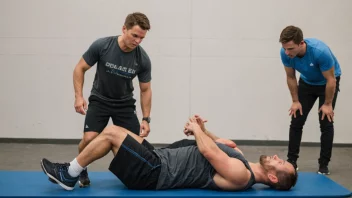Agility training has become an essential component in the repertoire of athletes across various sports disciplines. As the demand for performance excellence rises, so does the need to prioritize safety and injury prevention. This article delves into the significance of agility training in reducing the likelihood of injuries, enhancing athletic performance, and ultimately contributing to a more sustainable sporting career. We will explore the fundamental principles of agility training, its physiological benefits, specific exercises to incorporate, and how it can be tailored to different sports disciplines.
Understanding Agility Training
Agility is defined as the ability to move quickly and change direction with precision. It encompasses not just speed but also coordination, balance, and reaction time. Training for agility involves a variety of exercises designed to improve these skills, making it a multifaceted approach to athletic performance.
The Importance of Agility in Sports
In sports such as football, basketball, soccer, and even motorsports, athletes are frequently required to change direction rapidly, accelerate, and decelerate effectively. These movements are essential not only for performance but also for the safety of the athlete. A strong foundation in agility can lead to improved performance metrics, such as speed and reaction time, while also significantly reducing the risk of injuries.
How Agility Training Helps Prevent Injuries
Injury prevention is a critical concern for athletes at all levels. Agility training can play a pivotal role in minimizing the risk of injuries through several mechanisms:
1. Enhancing Joint Stability
Agility exercises often involve movements that require stabilization of joints, particularly the knees and ankles. Improved stability helps in preventing common injuries such as sprains and strains. Strengthening the muscles around these joints enhances their ability to withstand sudden movements, reducing the risk of injury.
2. Improving Coordination and Balance
Agility training incorporates various drills that enhance coordination and balance. Athletes who have better control of their body movements are less likely to experience falls or missteps that could lead to injuries. For instance, exercises like ladder drills help in creating a sense of body awareness, which is crucial in maintaining balance during high-intensity actions.
3. Developing Reaction Time
Quick decision-making is crucial in sports. Agility drills often include elements that require athletes to respond to stimuli, such as a coach's command or a change in the environment. By training these reaction times, athletes can avoid injuries that occur due to delayed responses to on-field situations.
4. Increasing Flexibility
Many agility exercises involve dynamic movements that enhance flexibility. Increased flexibility in muscles and tendons can help prevent injuries by allowing for a greater range of motion and decreasing muscle tightness. This is particularly important in sports that involve repetitive motions, such as cycling or football.
Effective Agility Training Exercises
A variety of exercises can be incorporated into an agility training program. Below are some effective drills that can be adapted to different sports:
Ladder Drills
- In-and-Out Drill: Step in and out of the rungs of the ladder, alternating feet. This exercise improves foot speed and coordination.
- Side Shuffle: Move laterally down the ladder while maintaining low body posture. This helps in developing lateral movement skills.
Cone Drills
- T-Drill: Set up cones in a T shape and sprint to the top cone, sideways shuffle to the left cone, and backpedal to the starting point. This drill enhances acceleration, deceleration, and change of direction.
- Figure 8 Drill: Set up two cones and weave in a figure-8 pattern. This helps in improving agility and spatial awareness.
Hurdle Drills
- Forward Hurdle Jumps: Jump over a series of low hurdles, focusing on speed and precision. This develops explosive power and coordination.
- Lateral Hurdle Jumps: Jump side-to-side over hurdles, emphasizing quick footwork and agility.
Integrating Agility Training into Your Routine
Integrating agility training into an athlete's regimen requires careful planning. Here are some tips to effectively incorporate agility work without overtraining:
- Assess Your Current Level: Before starting any new training regimen, it's important to evaluate your current agility level and identify areas for improvement.
- Set Specific Goals: Establish clear, measurable goals related to agility, such as improving your speed in a specific drill or reducing your reaction time.
- Start Slow: Begin with basic drills and gradually progress to more complex movements as your agility improves.
- Incorporate Rest Days: Allow adequate recovery time to prevent fatigue and overuse injuries.
Agility Training for Specific Sports
While agility training is beneficial for all athletes, it can be tailored to meet the specific demands of various sports:
Cycling
Agility training for cyclists can focus on bike handling skills and quick maneuvering, which are essential during races or in traffic. Drills that incorporate sudden stops and quick turns can significantly enhance a cyclist's performance and safety.
Football
In football, agility is crucial for both offensive and defensive players. Training can include cone drills that mimic game scenarios, helping players to improve their ability to evade tackles or pursue opponents.
Winter Sports
For athletes participating in winter sports, agility training can focus on lateral movements, balance, and quick shifts in weight. Skiers and snowboarders can benefit from drills that improve their ability to navigate through varied terrain.
Outdoor Activities
Outdoor athletes, such as hikers or trail runners, can utilize agility training to enhance their ability to navigate uneven terrain. Exercises that focus on quick foot placement and stability can make outdoor adventures safer and more enjoyable.
Conclusion
Agility training is a vital component of a comprehensive athletic training program designed to enhance performance and prevent injuries. By improving joint stability, coordination, balance, reaction time, and flexibility, athletes can not only perform at their best but also safeguard their health and longevity in sports. Incorporating specific agility drills tailored to the nuances of different sports can create more well-rounded athletes, equipped to face the dynamic challenges of their respective fields. As the world of sports continues to evolve, prioritizing injury prevention through agility training will remain a key focus for athletes committed to their craft.






